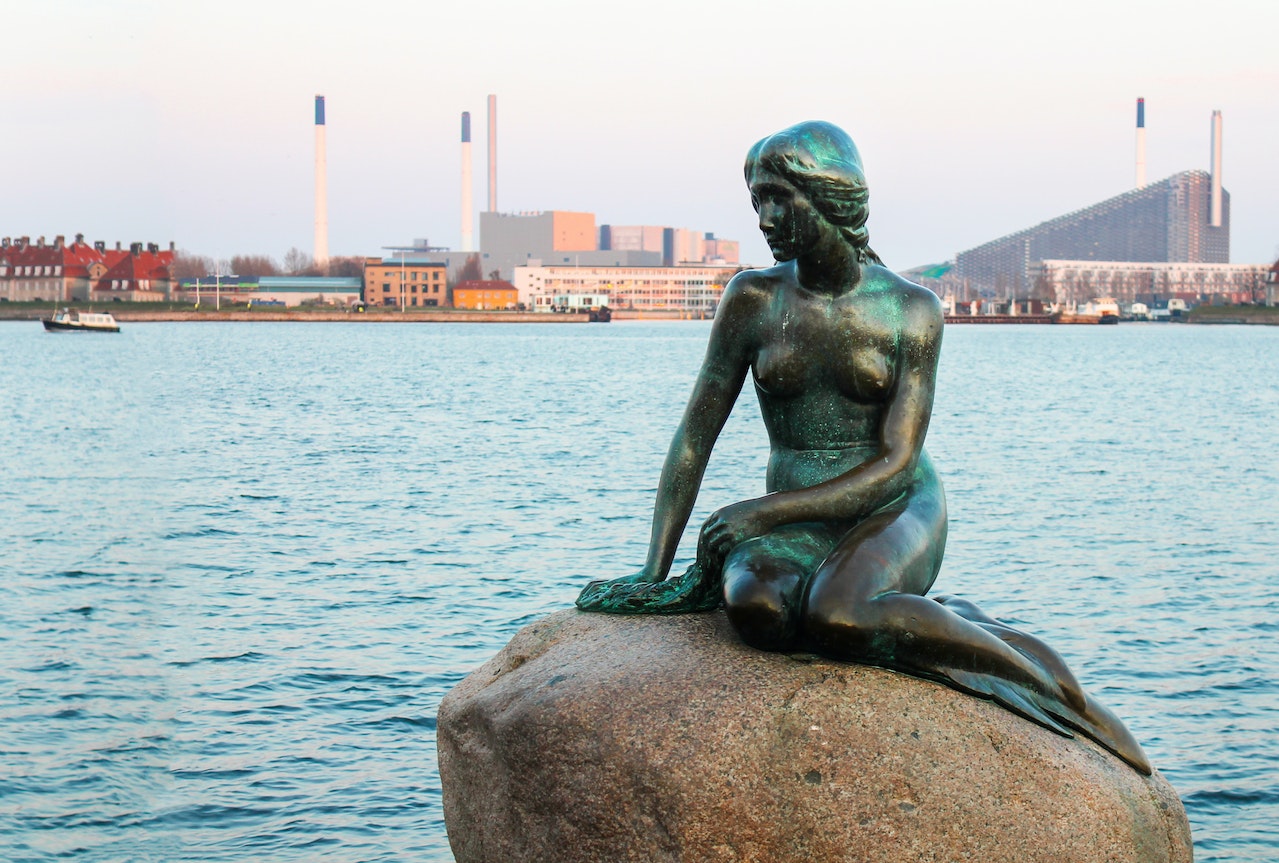The icon of Copenhagen
If you’re planning to visit Copenhagen, one of the most popular attractions you won’t want to miss is the statue of the Little Mermaid.
This iconic sculpture is located on the Langelinie pier. It is the symbol of the city and is a magnet for millions of tourists every year.
You can visit the statue on your own, but it’s worth considering a walking tour of Copenhagen to learn more about its history and culture. Many city tours include the Little Mermaid as one of their stops, allowing you not only to see the statue up close, but also to gain a deeper understanding of its significance to the people of Copenhagen.
The Little Mermaid is a 1913 sculpture by Danish sculptor Edvard Eriksen from the Hans Christian Andersen fairy tale. The statue depicts the mermaid sitting on a rock by the water’s edge, looking out over the harbour. Although it looks like a simple sculpture, it’s actually quite complex and detailed, with intricate details on the mermaid’s scales and flowing hair.
One of the reasons why the Little Mermaid is so popular is because of its emotional connection to the people of Copenhagen. The story of the Little Mermaid is one of sacrifice and love, and it resonates with many people around the world. In fact, the statue has become a symbol of the city’s resilience and strength, especially in times of turmoil and strife.
A walking tour of Copenhagen is a great way to learn more about the city’s history and culture. Many tours include stops at famous landmarks and attractions, such as the Little Mermaid, as well as lesser-known areas that offer an insight into daily life in the city.
During your walking tour, your guide is likely to tell you about the various stories and legends associated with the Little Mermaid. For example, some people believe the statue was modeled after Eriksen’s wife, while others believe it was inspired by ballerina Ellen Price, who danced in the Royal Danish Ballet. There are many urban legends surrounding the statue, including the idea that it’s cursed and brings bad luck to anyone touching it.
Walking around the city, you’ll also get a sense of the cost of living in Copenhagen, which can be quite high compared to other European cities. But don’t let the high prices put you off experiencing all the city has to offer. There are many ways to save money, such as using the city’s excellent public transport system, which includes buses, trains and the metro.
Another way to save money is to explore some of the lesser-known areas of the city, which can be just as interesting and enjoyable as the more popular tourist attractions. For example, check out the Nørrebro district, known for its vibrant street art and multicultural atmosphere. You can also visit the Assistens Cemetery, where many famous Danes are buried, including Hans Christian Andersen and Søren Kierkegaard.
All in all, a visit to the Little Mermaid is a must when you’re in Copenhagen, whether you do it on your own or as part of a walking tour. The statue is a symbol of the city’s rich history and culture, and it’s a reminder of the importance of sacrifice, love and resilience in our lives. So be sure to include a stop at the Little Mermaid on your next trip to Copenhagen and take the time to explore all that this beautiful city has to offer.
Here are some fun facts and incidents related to the Little Mermaid sculpture:
- The Little Mermaid sculpture was a gift to the city of Copenhagen by the brewer Carl Jacobsen, who was the son of the founder of the Carlsberg brewery. Jacobsen was inspired by a ballet performance of the fairytale and commissioned the sculpture as a tribute to the author Hans Christian Andersen.
- The original sculpture is made of bronze and stands about 1.25 meters tall. The Little Mermaid is depicted sitting on a rock by the waterside, gazing out to sea with a wistful expression on her face.
- The sculpture has become a popular target for vandals and pranksters over the years. It has been decapitated twice, had its arm severed, been painted several times, and even dressed up in a burqa as a political statement.
- In 1964, the Little Mermaid sculpture was temporarily moved to the Danish Pavilion at the World Expo in New York. The statue was returned to Copenhagen after the exhibition, but not before it was fitted with a bikini top to protect its modesty while it was on display in the United States.
- The Little Mermaid sculpture has inspired many copies and replicas around the world. There are at least six other copies of the statue, including one in Kimballton, Iowa, which was a gift from the Danish government to the town’s Danish-American community.
- The Little Mermaid sculpture has been the subject of several films, including the 1989 Disney animated movie The Little Mermaid. The statue has also appeared in several music videos, including “Barbie Girl” by Aqua and “Crazy in Love” by Beyoncé.
- The Little Mermaid sculpture has been the site of several protests and political demonstrations over the years. In 2004, the statue was draped in a Palestinian flag to protest the Israeli occupation of Gaza. In 2010, it was spray-painted with the words “racist fish” by activists who claimed that the statue was a symbol of colonialism and cultural oppression.
- The Little Mermaid sculpture is an important cultural symbol of Denmark and has been featured on postage stamps, coins, and banknotes. It is also one of the most photographed tourist attractions in the country.
- In 2013, the Little Mermaid sculpture celebrated its 100th anniversary with a big party in Copenhagen. The festivities included a parade, a concert, and a fireworks display.
- Despite its small size and relative simplicity, the Little Mermaid sculpture has captured the hearts and imaginations of people all over the world. It is a testament to the power of art and storytelling to transcend language and culture, and to create connections between people from all walks of life.






